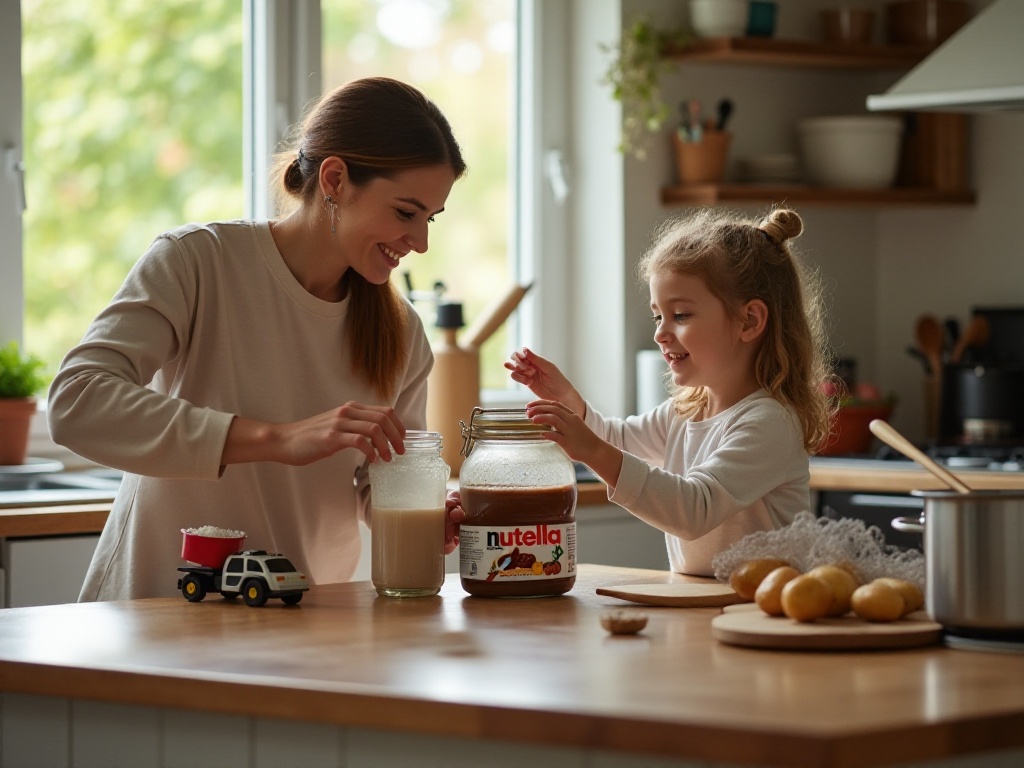
Introduction
To be honest, seeing the mess in the kitchen always gives me a headache! Appliance cords tangled like a giant spider web, seasoning bottles scattered everywhere, small items as hard to find as a needle in a haystack... I bet many people face these same problems. After a long period of exploration and practice, I've finally compiled a set of super practical storage and cleaning tips that I'd like to share with you today. I guarantee these will make your kitchen look brand new!
Kitchen Storage
Cable Management
When it comes to kitchen storage, appliance cords are perhaps the biggest headache. My kitchen is small but has many appliances: rice cooker, air fryer, food processor, electric kettle... Their cords often get tangled together, and it takes forever to find the right plug when needed. Once when I was in a hurry to use the rice cooker, I accidentally unplugged the electric kettle, causing my boyfriend's noodle water to go cold - so embarrassing!
Later, I discovered a clever solution using the plastic bag clips that come with bread. These clips come in various colors and are quite durable, perfect for categorizing and marking. Now I use red clips for the rice cooker cord, blue for the air fryer, yellow for the food processor, and green for the kettle. Each appliance's cord is neatly wrapped and secured with its corresponding colored clip, making everything organized and easy to find.
These clips are reusable too, so there's no need to buy special cable organizers, saving dozens of dollars right there. When my mom visited recently, she was so impressed with this storage method that she said she'd do the same at home.
Preventing Pot Boilovers
The most annoying thing about cooking noodles is when the water boils over. Once while I was cooking pasta, I turned away to cut tomatoes, and when I looked back, the water had spilled everywhere, making a mess of both the stove and my freshly cleaned floor. Later, I learned a super useful trick: simply placing a wooden spoon across the pot effectively prevents boilovers.
The principle is actually quite simple. The wooden spoon absorbs some heat and breaks the bubbles when they reach it, preventing water from spilling over. Now I use this trick whenever I cook noodles or soup, and I never worry about cleaning up spills anymore. Plus, the spoon on the pot reminds me to stir periodically, preventing noodles from sticking to the bottom.
Last week I used this method while cooking pasta for friends, and everything went smoothly. Everyone said this trick was brilliant. Just remember to use a wooden spoon - plastic ones might melt from the heat, and metal ones get too hot to be safe.
Food Preservation
When it comes to kitchen storage, food preservation is crucial. Like many others, I used to think wrapping everything in plastic wrap was the solution. However, this approach isn't suitable for all foods - some actually spoil faster when wrapped in plastic.
Take cheese, for example. Wrapping it in plastic wrap not only causes condensation but also affects its texture. The correct method is to wrap it in parchment paper, which allows proper air circulation, preventing it from becoming too dry or too moist. I often buy large blocks of cheddar cheese, and when wrapped in parchment paper and stored in the fridge, it can last over a month without spoiling - a real money-saver.
Vegetable and fruit preservation also requires specific techniques. For leafy vegetables like lettuce and chives, it's best to first dry them with kitchen paper, then wrap them in newspaper before placing them in a storage bag. This maintains appropriate moisture levels while preventing yellowing. The lettuce I bought last week was stored this way and stayed crisp and tender for a whole week.
As for fruits, easily perishable ones like strawberries can be rinsed with vinegar water and dried before storage to effectively prevent mold growth. For bananas, if you buy too many to eat, separate them and wrap the stems in plastic wrap to significantly extend their shelf life.
Seasoning Storage
Seasonings are perhaps the easiest things to become disorganized in the kitchen. I used to keep my seasonings randomly in the cabinet, spending ages finding what I needed when cooking. Later, I bought a rotating spice rack and organized the seasonings by frequency of use. The most commonly used items like salt, sugar, and soy sauce are placed in the most accessible positions, while less frequently used spices go in the back.
I also labeled each seasoning bottle with its purchase date and expiration date. This makes everything clear at a glance and prevents the use of expired seasonings. Once I discovered a bottle of garlic chili sauce that was about to expire, so I quickly used it to make twice-cooked pork - it tasted amazing. Without the label reminder, that sauce would probably have gone to waste.
For small bottles of seasonings, I transfer them into transparent glass jars, which not only look better but are also more convenient to use. Plus, the glass jars are reusable, saving money in the long run.
Kitchen Utensil Storage
When it comes to kitchen utensil storage, small items like spatulas and spoons can be the most troublesome. I used to get frustrated when I couldn't find the utensil I needed, sometimes frantically searching for a spatula in the middle of cooking.
Later, I installed a wall-mounted utensil rack near the sink to hang frequently used spatulas, strainers, and ladles. This not only saves space but makes everything easily accessible. I deliberately hang the most frequently used spatulas in the most convenient positions, so I don't have to search for tools while cooking.
For larger utensils like rolling pins and cutting boards, I store them vertically in the cabinet with dividers between them. This saves space and prevents items from knocking into each other. I also place kitchen paper between cutting boards to absorb excess moisture and prevent mold.
Cleaning Tips
Range Hood Cleaning
Cleaning the range hood has always been a headache. I used to just scrub it with dish soap, which was both laborious and ineffective. Later, I discovered a great method: soak the filter in hot water with baking soda and vinegar for about half an hour, and the grease comes off easily.
I now clean the range hood this way once a month with great results. Plus, baking soda and vinegar are household staples, so there's no need to buy special cleaners - it's both eco-friendly and economical. The cleaned range hood looks bright and doesn't have the unpleasant smell of chemical cleaners.
Microwave Cleaning
There's also a trick for cleaning microwaves. Fill a large glass bowl with water, add half a lemon, and microwave for 5 minutes. The steam softens the grease, while the natural acidity of the lemon removes odors. After the water cools, wipe with a cloth, and the grease comes off easily.
I cleaned my microwave this way last week - not only did it get clean, but it left a subtle lemon fragrance. The best part is that no chemical cleaners are needed, and the used lemon water can be poured down the sink to deodorize it - nothing goes to waste.
Cutting Board Deodorizing
Cutting boards develop odors over time, especially after cutting garlic, onions, and other aromatics. I've found that rubbing with lemon slices works particularly well, not only removing odors but also disinfecting. If you don't have lemons, table salt works too - just sprinkle a layer on the board, scrub, and rinse with clean water.
I now use different cutting boards for different ingredients, separating raw and cooked foods, which is both hygienic and extends the boards' lifespan. I regularly sanitize plastic cutting boards with boiling water and treat wooden ones with food-grade oil to prevent cracking.
Sink Deodorizing
Kitchen sinks easily accumulate dirt and develop unpleasant odors over time. I now clean the sink weekly using baking soda and vinegar. First pour baking soda down the drain, then add white vinegar, and flush with hot water after the foam subsides. This not only deodorizes but also unclogs the drain.
After using the sink, I wipe it dry to prevent water stains and limescale. I keep a small container next to the sink specifically for food scraps to prevent drain clogs.
Refrigerator Deodorizing
Refrigerators are also prone to developing odors. I regularly wipe the interior with warm water and vinegar, then place a box of baking soda inside to absorb odors. Vegetables and fruits are stored in separate containers to prevent any leaked liquids from dirtying the fridge.
After each shopping trip, I place new items at the back and move items closer to their expiration date to the front to avoid food waste. The door compartments are reserved for frequently used small condiment bottles, which is both convenient and space-efficient.
Food-Related Tips
Ingredient Preparation
Many people might not know that seemingly ordinary food preparation methods actually require specific techniques. For instance, when washing rice, the first rinse should be quick as it contains most of the dust and pesticide residues. The actual washing begins from the second rinse, continuing until the water becomes relatively clear.
When peeling potatoes, first make a few shallow marks on the surface with a spoon - this makes using the peeler much easier. I collect the potato peels to use as fertilizer for plants, so nothing goes to waste.
Food Storage
Besides the cheese storage method mentioned earlier, other ingredients also require specific storage techniques. For green onions, don't put them directly in the refrigerator after purchase. Instead, trim a small section off the roots, wrap the white parts in a plastic bag, then refrigerate to extend freshness.
Chives are best stored upright in a glass with a small amount of water, like flowers, with the leaves covered by a plastic bag. A similar method works for cilantro, but with less water to prevent root rot.
Kitchen Pest Control
Small flies are particularly annoying in the kitchen during summer. I've found that placing small dishes of vinegar around the sink works well - the vinegar smell repels flies while also deodorizing.
If ants invade, sprinkle baking soda powder or coffee grounds in their usual paths. These materials effectively repel ants and are non-toxic, so there's no worry about food contamination.

Life Efficiency
Cleaning Tool Storage
When it comes to cleaning, tool storage is also important. I installed a hook under the sink cabinet specifically for hanging cloths and scrubbers. This makes them easy to dry and access. I keep all cleaning supplies in a plastic basket that I can easily grab when needed.
Brooms and mops are stored upright in a corner of the balcony, with a small bucket nearby for cleaning supplies and cloths, so I don't have to search for tools when cleaning. I also use separate cloths for different areas - kitchen, bathroom, and living room - for better hygiene.

Waste Sorting
Waste sorting is another important aspect of improving life efficiency. I keep two trash bins under the cabinet - one for kitchen waste and another for other garbage. I wrap kitchen waste in newspaper before disposing of it, which keeps the bin clean and absorbs moisture.
Recyclables like paper and plastic bottles are flattened and collected until there's enough to process together. This is not only environmentally friendly but also saves space. Some recyclables can even be sold for money - though not much, it adds up over time.

Regular Deep Cleaning
While daily cleaning is important, regular deep cleaning is still necessary. I usually choose one weekend each month for deep cleaning, emptying and wiping all cabinets, checking for mold or insect damage.
During deep cleaning, I check all seasonings for expiration dates, prioritizing those about to expire. The refrigerator also gets a thorough cleaning, disposing of any food that's no longer fresh. Though time-consuming, this effectively prevents food safety issues.
Conclusion and Sharing
Through these life hacks, my kitchen management efficiency has improved significantly. Most importantly, these methods don't require much money - many solutions use items already available at home. Who would have thought something as simple as bread clips could be so useful for organizing cords?
Actually, there's wisdom like this everywhere in life - the key is to observe carefully and learn from experience. Often, the simplest methods are the most practical. As my grandmother used to say, "Life needs wisdom, but wisdom often comes from life."
These are experiences I've gathered from daily life, and I hope they're helpful to you. Of course, every household is different, and these methods might not all suit you. The important thing is to find what works best for your situation.
Do you face similar problems in your life? Or do you have better solutions? Feel free to tell me in the comments section, let's discuss and improve together. After all, life's wisdom needs to be shared to keep growing. I look forward to seeing your thoughts and experiences!




